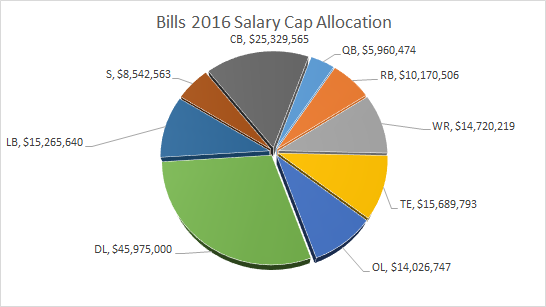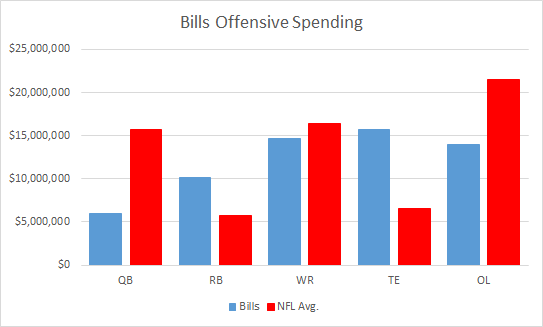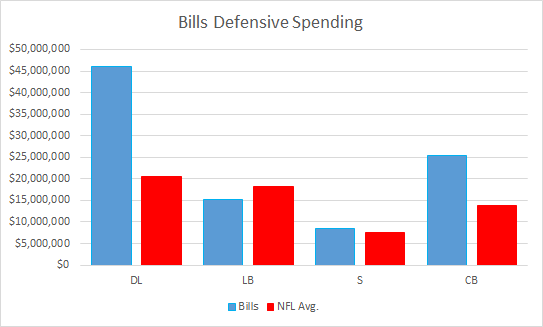Current Estimated 2016 Cap Space: $210,000
Expected 2016 Cap Space: $16.6 million
Estimated Rookie Cap: $4.880 million
Roster Overview
Players Under Contract: 67
Pro Bowlers: 1
Unrestricted Free Agents: 8(3 with 50%+ playtime)
Draft Selection: 19
Salary Cap Breakdown



Free Agents to Re-sign
Richie Incognito got a new lease on his NFL life when the Bills signed him last offseason and he ran with it having a great year. They would be foolish to let him go, though they could allow him to test the market if the feeling is the stigma around the league is still negative towards him…Recent contracts for Lane Johnson have likely increased Cordy Glenn’s asking price and I could also see a reason to let him test the market with an agreement of sorts to come back to Buffalo with any offer. I don’t think Glenn is worth top dollar but when you are as leveraged as the Bills you probably can’t afford to not have a known quantity at left tackle.
Free Agents to Let Walk
There may have been no better success story in NFL history out of making more money with less to show for it on the field than Percy Harvin. He’s always injured and only going to be effective as a third receiver at this point…In a weak group of free agent linebackers I could see Nigel Bradham landing a better than expected contract. I don’t believe he was impactful enough for the Bills to offer anything more than a one year deal to.
Contracts to Modify
As I wrote this the Bills had restructured the contract of Charles Clay, converting a roster bonus (or some portion of it) to a signing bonus. They should have saved around $8 million…The Bills should strongly consider extending Tyrod Taylor is they believe his is the quarterback of the next 3 to 4 years for the team….Stephon Gilmore is entering the final year of his contract and will count $11 million against the salary cap. He is going to want big money and the Bills would be better off signing him now to an extension if he is in their future plans. They can gain some added cap flexibility if they do that and take a somewhat strong stance in the negotiation…I would not be shocked if the Bills, who are already overinvested in Marcell Dareus, also restructured his deal to gain another $5 million in cap space…I would consider a late restructure on Kyle Williams which could save just under $3 million as a possibility to have in season funds to cover the accounting rules changes. That should not happen until the summer if its needed.
Players to Consider Releasing
Mario Williams has a $19.9 million cap hit and the Bills save $12.9 million by cutting him. The Williams contract was one of the most player friendly contracts in the NFL when it was signed and a deal almost impossible to live up to…The team can save $3.9 million on the cap by releasing Leodis McKelvin.
Salary Cap Analytics by Bryce Johnston
So far in this series we have covered mediocre teams with decent cap situations who must decide whether or not to make significant future salary cap commitments (such as the Rams and Lions) and previously successful teams in poor cap situations who now encounter a lack of flexibility as a result of attempting to maintain windows of opportunity (such as the Ravens and Saints), but the Bills are an example of a mediocre team in a poor cap situation encountering a lack of flexibility as a result of a failed attempt to transition from mediocre to something more than that. Unlike 2015 big-spending teams such as the Dolphins or Colts, it is not clear where the salary cap space will come from to make roster upgrades. Expected Contract Value 2.0 only forecasts a few releases in addition to the apparent Mario Williams release that can be considered slightly unexpected.
Because the Bills are starting with essentially zero cap space and are unlikely to make many cap-related cuts, further cap flexibility in 2016 will likely have to come from cap-related restructures that push true salary cap commitments into 2017. This effect on Commitment Index will be compounded by the likelihood that the Bills will carry little to no cap space forward from 2016, therefore not offsetting any 2017 commitments in the way that most teams will. In this team context, Tyrod Taylor’s 2016-2017 contract seasons may be the most valuable of any non-rookie contract in the entire league.
The Bills maintain $13 million worth of true salary cap commitment with respect to LeSean McCoy from 2016-2019 ($10.5 million worth of prorated signing bonus amounts and $2.5 million worth of guaranteed base salary). I note that this number was $0 immediately following the trade by which the Bills acquired McCoy from the Eagles. In exchange for assuming this $13 million in extra salary cap commitment pursuant to McCoy’s contract extension, the Bills obtained only $4.75 million worth of extra cap space in 2015 and actually lost roughly $500K worth of cap space in 2016 and roughly $1 million worth of cap space in 2017 relative to the terms of McCoy’s original deal as acquired by the Bills. Extending McCoy may have been effective human resource management, but it was highly questionable salary cap management.
–Bryce Johnston, @NFL Cap Analytics
Expected Contract Outcomes – Expected Contract Value 2.0 utilizes an algorithm based on a player’s contract characteristics, age, position and 2015 performance to forecast probabilities as to the outcomes of contract termination decisions. The lower the Expected Outcome, the more likely the player’s contract will be terminated in 2016. A pay cut is treated as a termination. We have applied ECV 2.0 to all contracts scheduled to count $2 million or more against the 2016 salary cap with the exception of exercised 5th year rookie options. Expected Savings is the calculated by multiplying the probability a player will be released by the cap savings realized by the team upon such release.
| Player | Position | Expected Outcome | Expected Savings |
| Sammy Watkins | REC | 99.9% | ($8,246) |
| Marcel Dareus | F7 | 99.8% | ($46,805) |
| Jerry Hughes | F7 | 99.1% | ($35,017) |
| Charles Clay | REC | 98.1% | ($112,200) |
| LeSean McCoy | RB | 96.7% | ($94,355) |
| Dan Carpenter | KP | 91.1% | $157,039 |
| Aaron Williams | DB | 84.9% | ($177,660) |
| Eric Wood | OL | 83.7% | $508,750 |
| EJ Manuel | QB | 79.8% | $0 |
| Corey Graham | DB | 66.6% | $894,788 |
| Mario Williams | F7 | 62.1% | $4,895,550 |
| Jerome Felton | RB | 54.3% | $160,020 |
| Manny Lawson | F7 | 53.3% | $1,238,345 |
| Kyle Williams | F7 | 19.8% | $4,010,500 |
| Kraig Urbik | OL | 10.8% | $1,582,945 |
| Leodis Mckelvin | DB | 10.4% | $3,494,010 |
| Expected Change in Cap Room | +$16,467,664 | ||
True Cap Space – Realizable Cap Space depicts the total amount of salary cap space potentially at the team’s disposal in 2016, and True Cap Space makes further adjustments to take into consideration amounts that are accounted for in practical terms. Most True Cap Space will be used on players currently under contract as a result of the team choosing to not release them.
| True Cap Space (2016) | |
| Adjusted Salary Cap | $155,209,124 |
| Prorated Signing Bonus Amounts | ($41,039,958) |
| Realizable Cap Space | $114,169,166 |
| Fully Guaranteed Salary | ($23,841,673) |
| Minimum Salary Cap Holds | ($21,600,000) |
| True Cap Space | $68,727,493 |
| League Rank | 29th |
Commitment Index – Commitment Index identifies the degree to which a team has “mortgaged its future” by measuring its net future salary cap commitments as a percentage of the average net future salary cap commitments of all teams. A Commitment Index Score of 100% is average, and a negative Commitment Index Score indicates that the team has more current salary cap space than future salary cap commitments. The Commitment Index Score of every team in the league changes to at least some degree with every transaction executed by any team in the league, so Commitment Index Score is measured as of a specific point in time (in this case, January 11, 2016).
| Commitment Index (2017+) | |
| Prorated Signing Bonus Amounts | $57,068,911 |
| Fully Guaranteed Salary | $3,138,491 |
| Current Cap Space | $6,223,991 |
| Net Commitment | $66,431,393 |
| Commitment Index Score | 385% |
| League Rank (1st = Most Committed) | 2nd |
Offseason Plan
Bryce really summed up the Bills salary cap perfectly when he described how the team attempted to go from mediocrity by leveraging the future badly last season. Right now the Bills are on track to be the next iteration of the Dallas Cowboys and New Orleans Saints. Those are the teams that overextended themselves on multiple contracts and have ended up in situations where they are at a competitive disadvantage for at least two seasons when it comes to working with the numbers on player contracts.
When the Bills signed Mario Williams a few years ago it was to prove they were not cheap and it was expected to change a culture. While I don’t think it changed the culture it did set the wheels in motion for what was coming in regards to player valuations in Buffalo. Now they come across a bit like the Raiders of the past where if you have a name they will bite and bite big. Clay, Dareus, and LeSean McCoy are all head scratching type of contracts. Like Williams you can argue the merits of the player (Dareus is clearly an elite talent) but there is almost no way to justify the contract structures in those deals.
When you move forward as an organization those kind of deals come back to bite you. It’s not just the deal itself and the issues with dead money, it’s how they impact the asking prices of other players. Glenn is going to want a big deal with similar player friendly features. So is Gilmore and Taylor. Next thing you know you are completely boxed in with a roster for the next few years.
The Bills, before the Clay restructure, already had the third worst on paper cap situation for 2017 ahead of only the Cowboys and the Ravens. Those numbers don’t include a left tackle looking for probably $10 million a season, a cornerback looking for $12 million, and a quarterback who just needs a pulse to get $17 million. Add those in and the Bills are going to be lagging by probably $10-15 million on the next closest team in any practical terms. This is why I think it’s important to rework Taylor’s contract now, because his price has the potential to go way up and the books could be so messed up that the team will need to dance to apply the franchise tag.
To keep things from getting out of control the Bills front office needs to really put an end to any thoughts of free agency this year and just address the team needs via the draft. The only position they probably should consider in free agency is a second target opposite Sammy Watkins only because I think it is better to get a sure thing than the developmental risk of the draft. This is an ok year for second tier receivers and the Bills are a rare team with a number 1 in place and a desperate need for a 2. That helps mitigate the free agent risk associated with picks.
But outside of that one position they should be focused on the draft. They can find linemen in the draft. They can find a linebacker and a safety or a defensive end. They can’t go to free agency for those spots to find high level starters no matter how tempting it may be to find ways to make it work from a financial standpoint. They are on the brink of disaster with their cap but can begin the process of coming off the ledge by being more controlled this year.
If they do decide to hit free agency again then it really is all or nothing for Buffalo this year. If they win nobody will care one bit about the future, but if they finish 7-9 or 8-8, it will probably be pretty ugly for the next few seasons as they struggle to find ways to improve.